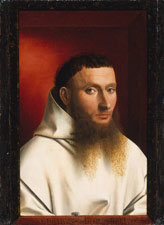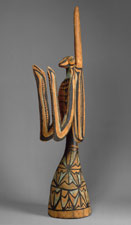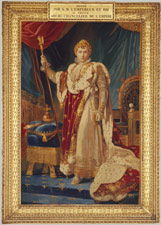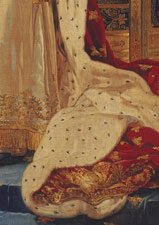New Connections appear every Wednesday. Sign up for a reminder.
Educator Edie Watts highlights the subtle and surprising instances where bugs are depicted throughout works in the Met's collection.
 1280852
1280852 8271024
8271024 8551024
8551024 5391024
5391024 10241024
10241024 1280933
1280933 1280900
1280900 8921024
8921024 7441024
7441024 884884
884884 1280790
1280790 12801007
12801007 5951024
5951024 1280738
1280738 1280869
1280869 9651024
9651024 7311024
7311024 7151014
7151014 8141024
8141024 11101024
11101024 6711024
6711024 12311024
12311024 1280852
1280852
My name is Edie Watts, I've worked at this Museum in education for many, many years. And my topic is bugs.
Most bugs I've always been interested in, because every summer growing up, I spent on the beach near New York City, in a place that is definitely favored
by mosquitoes. I don't know who the mosquito deity was, but I would make offerings to him or her to protect me from bites.
From the very earliest age I can remember swatting whenever I heard that buzzing sound that mosquitoes make.
In the spring, you begin to hear certain kinds of bugs. The bug that symbolizes the season for me are
crickets. In the country, in August, when the moon is full, the nights are always still and you hear the wonderful sounds of the insects. At Fire Island
every September, hundreds of monarch butterflies come flying through, all the way to Mexico to spend the winter. Amazing!
Some cultures use bugs for symbols.
In this beautiful, realistic, gentle portrait of a monk, on the ledge in front of this holy man, is a fly.
It is a symbol of mortality. We're all going to be covered with flies one day.
The Egyptians were fascinated by the beetle because in the sands they would see these beetles rolling balls of dung around into their nests. They thought,
"Ah, a giant invisible beetle moves the sun through the sky." The beetle became a sign of the sun, and of the powers of the king.
In Australia, the praying mantis was a symbol of head-hunting, since the female, having mated with the male, then chopped off his head.
I don't think any of them are creepy or scary. I think the spiders carry potentially interesting messages.
Perhaps some people might not be fond of handling a little bug in pouring their coffee, but oh, I just...I would love it! Isn't it fun to sort of be careful
when you take the lid off of the sugar pot and the milk pot—it's just a friendly little bug, it's just a little beetle.
Napoleon felt he should have some wonderful emblem embroidered on his robes. The bee
is industrious. The bee has a very highly organized society with royalty at the top. And of course the bee can also sting.
Most bugs that appear in this Museum are life-size, so you have to
really look. And a lot of them tell a story, have a symbol, have a meaning.
It sharpens one's eye for looking for details
because details can be very important.
 |
 |
 |
 |
 |
 |
 |
 |
 |
 |
 |
 |
 |
 |
 |
 |
 |
Works of art in order of appearanceLast Updated: June 22, 2015. Not all works of art in the Museum's collection may be on view on a particular day. For the most accurate location information, please check this page on the day of your visit. |
||
 |
Parasol spring/summer 1937 Elsa Schiaparelli (Italian) Cotton, wood Brooklyn Museum Costume Collection at The Metropolitan Museum of Art, Gift of the Brooklyn Museum, 2009; Gift of Arturo and Paul Peralta-Ramos, 1955 (2009.300.1224) More information: The Collection Online Not on view
|
 The Costume InstituteFirst Floor
The Costume InstituteFirst Floor |
 |
Mosquito Deity amulet Late Period, Dynasty 25–30, ca. 712–332 b.c. Egypt Green-and-White banded jasper Gift of Cyril Aldred, 1955 (55.172) More information: The Collection Online Not on view
|
 Egyptian ArtFirst Floor
Egyptian ArtFirst Floor |
 |
Fly Whisk (Tahiri [?]) early to mid-19th century Probably Rurutu or Tupua'i, Austral Islands, French Polynesia Wood, fiber, human hair The Michael C. Rockefeller Memorial Collection, Bequest of Nelson A. Rockefeller, 1979 (1979.206.1487) More information: The Collection Online Not on view
|
 Arts of Africa, Oceania, and the AmericasFirst Floor
Arts of Africa, Oceania, and the AmericasFirst Floor |
 |
Netsuke: Autumn grasses with praying mantis 18th century Attributed to Ryûsa (Japanese) Carved ivory Gift of Mrs. Russell Sage, 1910 (10.211.1271) More information: The Collection Online Not on view
|
 Asian ArtSecond Floor
Asian ArtSecond Floor |
 |
Autumn Grasses in Moonlight Meiji period, ca. 1872–91 Shibata Zeshin (Japanese) Two-panel folding screen; ink, lacquer, and silver leaf on paper The Harry G. C. Packard Collection of Asian Art, Gift of Harry G. C. Packard, and Purchase, Fletcher, Rogers, Harris Brisbane Dick, and Louis V. Bell Funds, Joseph Pulitzer Bequest, and The Annenberg Fund Inc. Gift, 1975 (1975.268.137) More information: The Collection Online Not on view
|
 Asian ArtSecond Floor
Asian ArtSecond Floor |
 |
In Fairyland: A Series of Pictures from the Elf-World 1870 Richard Doyle (British) Color lithography Gift of Lincoln Kirstein, 1970 (1970.565.74) More information: The Collection Online Not on view
|
 Drawings and PrintsSecond Floor
Drawings and PrintsSecond Floor |
 |
Jar with decoration of flowers and insects Joseon dynasty, mid-18th century Korea Porcelain with underglaze cobalt blue Purchase, Parnassus Foundation/Jane and Raphael Bernstein Gift, and Diane Carol Brandt Gift, 2005 (2005.406) More information: The Collection Online Not on view
|
 Asian ArtSecond Floor
Asian ArtSecond Floor |
 |
Portrait of a Carthusian 1446 Petrus Christus (Netherlandish) Oil on wood The Jules Bache Collection, 1949 (49.7.19) More information: The Collection Online Not on view
|
 European PaintingsSecond Floor
European PaintingsSecond Floor |
 |
Heart Scarab of Hatnofer New Kingdom, Dynasty 18, ca. 1492–1473 b.c. Egypt, Upper Egypt Serpentine, gold Rogers Fund, 1936 (36.3.2) More information: The Collection Online Not on view
|
 Egyptian ArtFirst Floor
Egyptian ArtFirst Floor |
 |
Rhinoceros beetle box Macedonian and Ptolemaic Period, 664–30 b.c. Egypt Bronze or copper alloy Purchase, Edward S. Harkness Gift, 1926 (26.7.855) More information: The Collection Online Not on view
|
 Egyptian ArtFirst Floor
Egyptian ArtFirst Floor |
 |
Headdress (Kapurei [?]) late 19th–early 20th century Sulka people, New Britain Wood, paint Gift of Evelyn A. J. Hall, 1981 (1981.331.1) More information: The Collection Online Not on view
|
 Arts of Africa, Oceania, and the AmericasFirst Floor
Arts of Africa, Oceania, and the AmericasFirst Floor |
 |
Nose ornament with spiders 1st century b.c.–1st century a.d. Peru; Salinar (?) Gold The Michael C. Rockefeller Memorial Collection, Bequest of Nelson A. Rockefeller, 1979 (1979.206.1172) More information: The Collection Online Not on view
|
 Arts of Africa, Oceania, and the AmericasFirst Floor
Arts of Africa, Oceania, and the AmericasFirst Floor |
 |
Coffee service 1900–1904 Designer: Lèon Kann (French); Sèvres Manufactory (French) Hard-paste porcelain Gift of Diane R. Wolf, 1988 (1988.287.1a, b) More information: The Collection Online Not on view
|
 European Sculpture and Decorative ArtsFirst Floor
European Sculpture and Decorative ArtsFirst Floor |
 |
Tapestry: Portrait of Napoleon I 1808–11 After a painting by Baron François-Pascal-Simon Gèrard (French); Gobelins Royal Manufactory; Workshop of Michel-Henri Cozette (French) High-warp tapestry of wool, silk, and silver-gilt thread Purchase, Joseph Pulitzer Bequest, 1943 (43.99) More information: The Collection Online Not on view
|
 European Sculpture and Decorative ArtsFirst Floor
European Sculpture and Decorative ArtsFirst Floor |
 |
Necklace fall 1938 Elsa Schiaparelli (Italian); Jean Clemént (French) Plastic, metal Brooklyn Museum Costume Collection at The Metropolitan Museum of Art, Gift of the Brooklyn Museum, 2009; Gift of Arturo and Paul Peralta-Ramos, 1955 (2009.300.1234) More information: The Collection Online Not on view
|
 The Costume InstituteFirst Floor
The Costume InstituteFirst Floor |
 |
Hair ornament ca. 1904 Louis Comfort Tiffany (American) Silver, enamel, black and pink opals, demantoid garnets Gift of Linden Havemeyer Wise, in memory of Louisine W. Havemeyer, 2002 (2002.620) More information: The Collection Online Not on view
|
 American Decorative ArtsFirst and Second Floors
American Decorative ArtsFirst and Second Floors |
 |
Madonna and Child ca. 1480 Carlo Crivelli (Italian, Venetian) Tempera and gold on wood The Jules Bache Collection, 1949 (49.7.5) More information: The Collection Online Not on view
|
 European PaintingsSecond Floor
European PaintingsSecond Floor |
© 2011 The Metropolitan Museum of Art |
||





